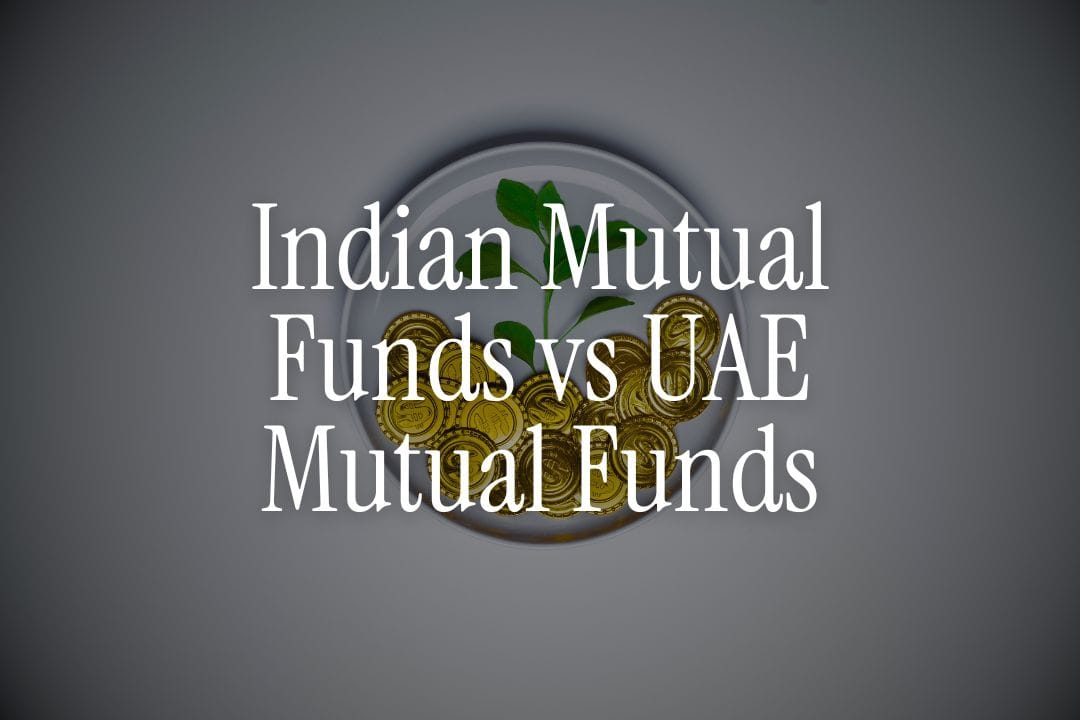
You're sitting in your Dubai office, deciding where to invest your savings.
Indian mutual funds? Or local UAE options?
We get this question from every NRI client we meet.
Last week, Ahmed, a senior manager at a UAE bank, asked us: if he can invest ₹5 lakhs monthly, Should he stick to Indian funds or explore what's available here in UAE?"
His confusion is understandable. Both markets offer mutual funds, but they're completely different beasts.
After helping many NRIs make this choice, We are here to give you the straight facts.
No fluff, no bias-just practical guidance to help you decide.
The Bottom Line Upfront
For most UAE-based NRIs: Indian mutual funds win decisively.
Here's why in numbers:
- Tax advantage: 0% capital gains tax on Indian funds for UAE residents vs UAE funds taxed at home country rates
- Returns: Indian equity funds averaged 15-18% annually vs UAE funds at 8-12%
- Choice: 2,000+ Indian funds vs ~50 meaningful UAE options
- Costs: Indian fund expense ratios 0.5-2% vs UAE funds 1.5-3%
But there are specific scenarios where UAE funds make sense. Let me break it all down.
Also Read -The Complete NRI Status Guide for UAE Residents
Understanding the Landscape
Indian Mutual Funds: The Massive Market
India's mutual fund industry manages $893+ billion across 2,000+ schemes. You get everything from aggressive small-cap funds to conservative debt options. (source)
Key players: SBI, HDFC, ICICI, Axis, Mirae Asset, and dozens more.
UAE Mutual Funds: The Limited Local Scene
UAE's mutual fund space is dominated by local banks offering basic options. The sophisticated fund ecosystem operates through DIFC and ADGM financial centers, but primarily targets institutional investors.
Key players: Emirates NBD Asset
Management, ADCB, FAB, plus some international players in DIFC.
👉 Tip: Don't confuse "UAE mutual funds" with international funds sold by UAE banks. Those are different products entirely.
- Also Read - Best Mutual Funds for NRIs to Invest in Indi
Tax Implications: The Game Changer
This is where Indian funds become almost unbeatable for UAE residents.
Indian Mutual Funds Tax Benefits
Thanks to the India-UAE Double Taxation Avoidance Agreement (DTAA):
Tax Type | Indian Rate | UAE Rate | Your Effective Rate |
|---|---|---|---|
Capital Gains | 10-20% normally | 0% (no personal tax) | 0% |
Dividend Income | 30% TDS | 0% | Potentially 0%* |
Interest Income | 30% TDS | 0% | Potentially 0%* |
*With proper Tax Residency Certificate (TRC) filing.
Real example: My client Priya invested ₹50 lakhs in Indian equity funds. After 5 years, she redeemed ₹1.2 crores.
- Normal tax liability: ₹7 lakhs
- Her actual tax: ₹0 (thanks to DTAA)
Also Read - Taxation on Mutual Funds
UAE Mutual Funds Tax Treatment
UAE mutual funds face a different scenario:
- No local tax: UAE doesn't tax investment gains for residents
- Source country tax: Funds investing globally face withholding taxes from those countries
- Home country complications: If you return to India, these gains might be taxable
Performance Comparison: Numbers Don't Lie
Let's look at actual returns over the past 5 years:
Indian Mutual Funds Performance (2020-2025)
Category | Best Performers | Average Returns |
|---|---|---|
Large Cap Equity | Mirae Asset Large Cap, HDFC Top 100 | 15-17% annually (source) |
Mid Cap Equity | Motilal Oswal Midcap, HDFC Mid-cap | 18-22% annually |
Small Cap Equity | SBI Small Cap, Nippon Small Cap | 20-25% annually |
Debt Funds | HDFC Corporate Bond, ICICI Banking PSU | 7-9% annually |
UAE Mutual Funds Performance (2020-2025)
Category | Key Options | Average Returns |
|---|---|---|
UAE Equity | ADCB UAE Equity, Emirates NBD UAE Equity | 6-10% annually (source) |
GCC Regional | FAB GCC Equity, ADCB MENA Fund | 6-10% annually |
Money Market | Emirates Islamic Money Market | 3-5% annually |
Balanced Funds | ADCB Islamic Balanced | 7-9% annually |
Clear winner: Indian funds consistently outperformed UAE funds across categories.
*Top-performing Indian Small Cap equity funds have delivered annualized returns up to 20-25% over the last 5 years, while UAE equity funds, like the ADCB UAE Equity Fund at ~12.8%, have seen more modest returns."
Investment Options: Depth vs Breadth
Indian Mutual Funds: Endless Choices
You can invest in:
- Sector-specific funds: Banking, pharma, tech, infrastructure
- Theme-based funds: ESG, consumption, digital India
- International funds: US equity, global equity, China funds
- Hybrid options: Balanced advantage, aggressive hybrid
- Tax-saving: ELSS funds with 3-year lock-in
Search and selection: Advanced tools from Groww, Zerodha, ICICI Direct help you filter 2,000+ options by performance, risk, expense ratio.
Also Read - Types of Mutual Funds
UAE Mutual Funds: Limited but Focused
Your options are restricted to:
- Local equity funds: Focus on UAE and GCC markets
- Sharia-compliant options: Islamic funds following religious guidelines
- Conservative choices: Money market and balanced funds
- Regional exposure: MENA region funds
Search and selection: Basic tools from local banks. Limited research and comparison platforms.
👉 Tip: UAE banks often push their own funds. Always compare with independent research before investing.
Also Read -Best Monthly Investment Plans in UAE
Costs and Fees: Every Basis Point Matters
Indian Mutual Funds: Competitive Pricing
Fund Type | Typical Expense Ratio | Entry Load | Exit Load |
|---|---|---|---|
Index Funds | 0.1-0.5% | Nil | Nil |
Large Cap Active | 0.8-1.5% | Nil | Nil/1% if \< 1 year |
Mid/Small Cap | 1.0-2.0% | Nil | 1-2% if \< 1 year |
Debt Funds | 0.3-1.0% | Nil | 0.25-1% if \< 1 year |
UAE Mutual Funds: Higher Cost Structure
Fund Type | Typical Expense Ratio | Entry Load | Exit Load |
|---|---|---|---|
UAE Equity | 1.5-2.5% | 0-3% | 1-3% if \< 1 year |
Regional Funds | 2.0-3.0% | 1-3% | 1-3% if \< 1 year |
Money Market | 0.8-1.5% | 0-1% | 0.5-1% if \< 6 months |
Balanced Funds | 1.8-2.8% | 1-2% | 1-2% if \< 1 year |
Cost impact example:
- ₹10 lakhs in Indian large cap fund: Annual cost ~₹10,000-15,000
- ₹10 lakhs in UAE equity fund: Annual cost ~₹20,000-30,000
Over 10 years, this difference compounds significantly.
Currency Risk: The Double-Edged Sword
Indian Mutual Funds Currency Exposure
Rupee depreciation risk: Your biggest concern with Indian investments.
Historical INR performance vs AED:
- 2020: 1 AED = ₹20.2
- 2025: 1 AED = ₹22.8
- Depreciation: ~3% annually
Impact: Even if your Indian fund returns 15%, rupee depreciation reduces AED returns to ~12%.
Hedging options:
- GIFT City USD Fixed Deposits eliminate currency risk
- Currency hedged funds (limited options in India)
- Natural hedge through diversification
Also Read -Best Fixed Deposit Rates in UAE
UAE Mutual Funds Currency Profile
AED-denominated funds: Zero currency risk for UAE residents.
Multi-currency exposure: Many UAE funds invest globally, creating exposure to USD, EUR, and other currencies.
Advantage: Predictable returns in your spending currency (AED).
Regulatory Framework: Safety and Oversight
Indian Mutual Funds Regulation
Regulator: Securities and Exchange Board of India (SEBI)
- Investor protection: Strong regulatory framework
- Transparency: Daily NAV disclosure, regular portfolio updates
- Complaint resolution: Established grievance mechanisms
- Track record: 30+ years of evolution and refinement
NRI-specific rules:
- Investment through NRE/NRO accounts only
- KYC compliance mandatory
- FATCA/CRS declarations required
Also Read - How NRIs Can Invest in Mutual Funds from Abroad
UAE Mutual Funds Regulation
Multiple regulators:
- Onshore funds: Securities and Commodities Authority (SCA)
- DIFC funds: Dubai Financial Services Authority (DFSA)
- ADGM funds: Financial Services Regulatory Authority (FSRA)
Advantages:
- Modern regulatory framework
- Strong investor protection
- English common law basis (DIFC/ADGM)
Challenges:
- Newer regulatory environment
- Limited track record
- Fragmented oversight
Accessibility and Minimum Investments
Indian Mutual Funds: Easy Entry
Minimum investments:
- SIP: ₹100-500 monthly
- Lump sum: ₹1,000-5,000
Access methods:
- Online platforms (Groww, Zerodha, Kuvera)
- Bank websites (ICICI Direct, HDFC Securities)
- Direct AMC websites
- Mobile apps with UAE support
Documentation: Standard NRI KYC + bank account linking.
UAE Mutual Funds: Higher Barriers
Minimum investments:
- Local bank funds: AED 3,000-10,000
- DIFC/ADGM funds: USD 100,000-1,000,000 (accredited investors)
Access methods:
- Bank relationship managers
- Wealth management platforms
- Limited online self-service options
Documentation: UAE residence visa + local bank account mandatory.
Liquidity and Redemption
Indian Mutual Funds Flexibility
Redemption time: 1-3 working days to NRE/NRO account.
Partial redemption: Allowed anytime (subject to exit loads).
SWP options: Systematic Withdrawal Plans for regular income.
Repatriation:
- NRE investments: Unlimited repatriation
- NRO investments: Up to $1 million annually
Also Read - How to Repatriate Mutual Fund Proceeds to Your Country
UAE Mutual Funds Process
Redemption time: 2-5 working days to UAE bank account.
Partial redemption: Available but may have higher minimum balance requirements.
Regular withdrawal: Limited systematic options.
Cross-border transfers: Need separate remittance for international transfers.
Practical Investment Strategies
Strategy 1: India-First Approach (Recommended for Most)
Allocation:
- 70% Indian equity funds (Best Indian Mutual Funds)
- 20% Indian debt funds
- 10% GIFT City USD deposits (currency hedge)
Advantages:
- Maximum return potential
- Tax efficiency
- Diversification within Indian economy
Best for: NRIs with 5+ year investment horizon and moderate risk tolerance.
Strategy 2: Balanced Geography Approach
Allocation:
- 50% Indian funds (focus on large cap for stability)
- 30% UAE/regional funds
- 20% Global funds through UAE platforms
Advantages:
- Geographic diversification
- Currency risk reduction
- Local market exposure
Best for: Conservative investors wanting geographic balance.
Strategy 3: UAE-Heavy Approach
Allocation:
- 30% Indian funds (only large cap)
- 50% UAE funds
- 20% International funds
Advantages:
- Minimal currency risk
- Local regulatory comfort
- Simple tax treatment
Best for: Risk-averse investors or those planning permanent UAE residence.
When to Choose UAE Funds
Despite Indian funds' advantages, UAE funds make sense in specific situations:
Scenario 1: Currency Risk Aversion
If INR depreciation keeps you awake at night, UAE funds offer peace of mind.
Scenario 2: Short Investment Horizons
For 1-3 year goals, currency stability outweighs return potential.
Scenario 3: Compliance Complexity
US citizens face FATCA complications with Indian funds. UAE funds might be simpler.
Scenario 4: Local Market Belief
If you believe UAE/GCC markets will outperform India (unlikely but possible).
Scenario 5: Regulatory Comfort
Some investors prefer dealing with local regulators and English common law.
Step-by-Step: How to Invest in Each
Investing in Indian Mutual Funds from UAE
- Open NRE/NRO account with Indian bank having UAE presence
- Complete KYC with overseas address documentation
- Choose investment platform (recommend ICICI Direct or Groww)
- Fund transfer from UAE to Indian account
- Start investing through SIP or lump sum
Timeline: 2-3 weeks for complete setup.
Our recommendation: Start with Belong's NRI mutual fund guide for detailed process.
Investing in UAE Mutual Funds
- Open UAE bank account (salary transfer relationships get better terms)
- Meet with relationship manager to discuss investment goals
- Review fund options (limited but focused selection)
- Complete investor profiling and documentation
- Make initial investment (higher minimums)
Timeline: 1-2 weeks if you have banking relationship.
Tax Planning Strategies
Maximizing DTAA Benefits (Indian Funds)
- Obtain Tax Residency Certificate (TRC) from UAE authorities
- File Form 10F with Indian tax authorities
- Keep detailed records of all transactions
- Plan redemptions during UAE residency periods
- Consider professional help for complex situations
Optimizing UAE Fund Taxation
- Understand source country taxes on underlying investments
- Plan exit timing based on future residence plans
- Keep investment records for potential future tax obligations
- Consider Sharia-compliant options if relevant
👉 Tip: Consult with tax advisors familiar with both Indian and UAE tax laws for personalized strategies.
Common Mistakes to Avoid
Mistake 1: Ignoring Currency Impact
Don't just look at INR returns. Calculate AED-adjusted performance for true comparison.
Mistake 2: Chasing Past Performance
Last year's top performer often becomes this year's laggard. Focus on consistency.
Mistake 3: Overcomplicating
You don't need 20 different funds. 5-7 well-chosen funds provide sufficient diversification.
Mistake 4: Neglecting Costs
High expense ratios compound over time. A 1% annual fee becomes 10% over 10 years with compounding.
Mistake 5: Poor Documentation
Maintain proper records for tax compliance in both countries.
Future Outlook: What's Changing
Indian Market Trends
- Digital transformation: Fintech making investing easier for NRIs
- Product innovation: New fund categories and international exposure
- Regulatory evolution: SEBI improving NRI investment experience
UAE Market Developments
- DIFC growth: More sophisticated funds launching
- Retail expansion: Banks expanding mutual fund offerings
- Regulatory alignment: Better coordination between UAE financial centers
Making Your Decision: The Framework
Ask yourself these key questions:
1. Investment Horizon
- 5+ years: Indian funds likely better
- 1-3 years: Consider UAE funds for stability
2. Risk Tolerance
- High: India offers more upside potential
- Low: UAE provides more predictability
3. Tax Situation
- UAE resident: Indian funds have clear tax advantage
- Future plans unclear: Consider mixed approach
4. Convenience Priority
- Growth focus: Accept Indian fund complexity for returns
- Simplicity focus: UAE funds might be worth lower returns
5. Investment Amount
- Large amounts (₹50L+): Tax savings from Indian funds make complexity worthwhile
- Smaller amounts: Convenience might matter more
Our Recommendation
For most UAE-based NRIs, Indian mutual funds should form 70-80% of your portfolio.
Ideal allocation:
- 60% Indian equity funds (mix of large, mid, small cap)
- 15% Indian debt funds
- 15% GIFT City USD Fixed Deposits (currency hedge)
- 10% UAE funds (for local exposure and stability)
This gives you:
✅ Maximum return potential
✅ Tax efficiency
✅ Some currency hedge
✅ Geographic diversification
Start simple: Begin with 2-3 Indian funds + 1 GIFT City deposit. Add complexity only as your knowledge grows.
Taking Action
Ready to start? Here's your immediate next step:
For Indian funds: Download Belong's app to explore our comprehensive NRI investment platform, including access to Indian mutual funds and GIFT City products.
For ongoing guidance: Join our WhatsApp community where 2,000+ NRIs share real experiences about investing from UAE.
Need personalized advice? Our SEBI-registered advisors specialize in NRI portfolios combining the best of Indian and international markets.
The choice between Indian and UAE mutual funds isn't just about numbers-it's about building a financial strategy that works for your unique situation as an NRI.
Most successful NRIs I work with don't see this as either/or. They use both markets strategically, with Indian funds driving growth and UAE options providing stability.
Start with the tax-efficient Indian funds, add GIFT City products for currency hedging, and use UAE funds for the final 10-20% of diversification.
Your future self will thank you for making this decision with data, not emotions.
Sources:
- SEBI Mutual Fund Industry Data
- Securities and Commodities Authority UAE
- India-UAE DTAA Agreement
- Emirates NBD Asset Management Performance Data
- ADCB Investment Performance Reports
Disclaimer: This article is for informational purposes only. Mutual fund investments are subject to market risks. Past performance doesn't guarantee future results. Please consult qualified financial advisors before making investment decisions.




